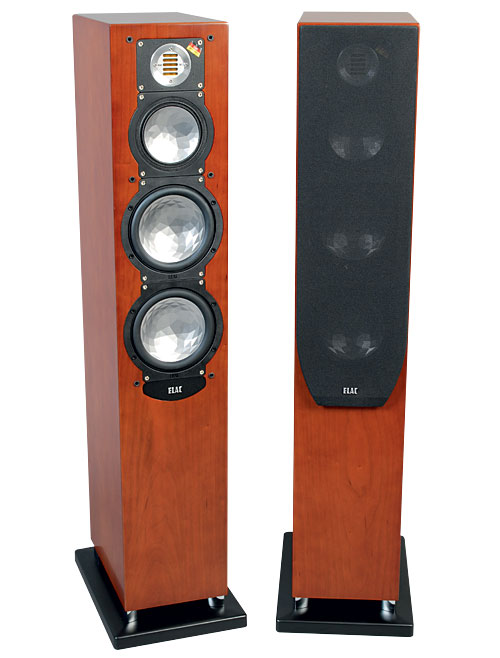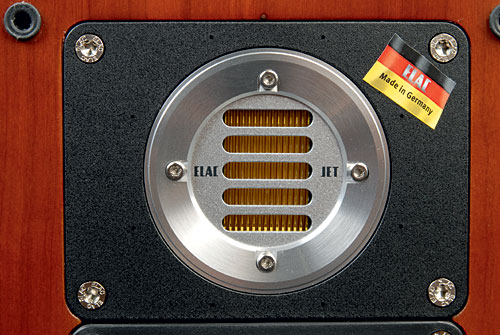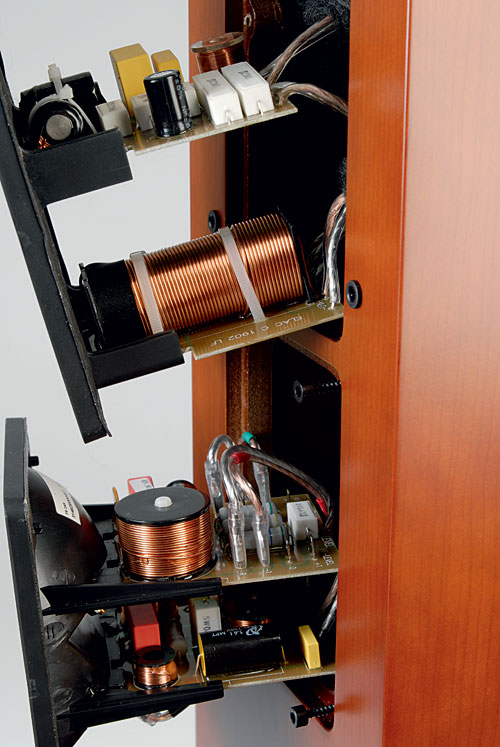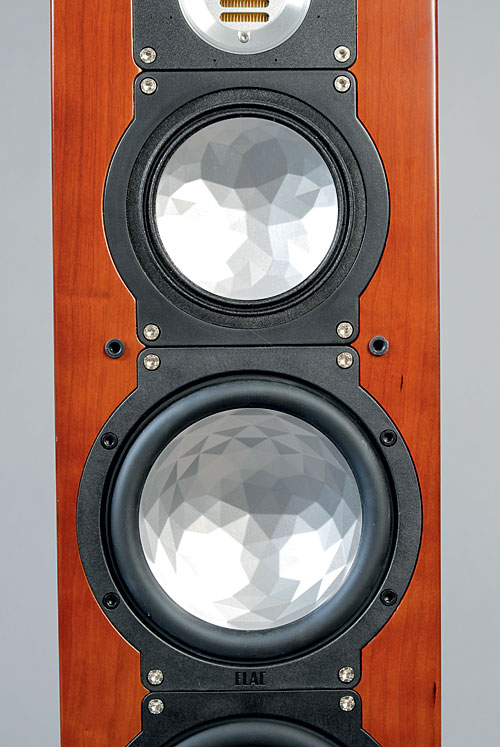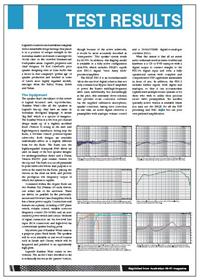Elac FS 249 - Best Speaker 2009 in Australia
"The ELAC FS249s just respond to increases in volume in text-book fashion, by simply delivering more of the same… except louder!"
The Germans seem to love their technology more than almost everything else, yet most of the time they succeed in making their products look beautiful as well. (The Italians seem to approach manufacturing the other ‘way around, with sometimes inconsistent results!) The new ‘crystal’ cones fitted to ELAC’s FS249 are certainly beautiful, and they look very much like the inside of a geodesic dome. And if that word brings to mind the famous US architect Richard Buckminster Fuller, who most people think invented the geodesic dome, we should point out right away that the geodesic dome is a German invention, designed and patented by none other than Walther Bauersfeld, when he was working at Carl Zeiss. Zeiss built the first geodesic dome on the roof of its factory in Jena, in Germany, in 1922. (Richard ‘Bucky’ Fuller was certainly responsible for coining the English word ‘geodesic’ and also popularised the design so, for reasons best known to the US Patent Office, was granted a patent for it, despite Bauersfeld’s patent predating his by more than two decades!)
One reason for all this talk of patents is that ELAC has patents pending on its ‘Crystal Membrane’ drivers, which are actually based on aluminium sandwich technology, rather than the geodesic dome. This is because despite its geodesic shaping, the aluminium foil of ELAC’s crystal cones is not self-supporting. Instead, the foil is glued to an underlying paper cone. As you can see from the photograph, all three cone drivers on the FS249 use the technology. What you can’t see from the photo is that ELAC has also secured the ‘sandwich’ cone in a highly unusual manner. Whereas most cones connect to the voice coil former only around the circumference of the former itself, ELAC uses additional strutting to connect the periphery of the former to the exact centre of the cone. The company claims that this design, in combination with the sandwich of the stamped aluminium and paper cone, increases the driver’s bandwidth by ‘nearly an octave’ irrespective of whether it’s a midrange driver or a bass driver. It’s for this reason that these particular ELAC drivers are known as ‘XR’ (eXtended Range) types. The EquipmentAs you can also probably see from the photograph, there is more ‘high-tech’ in the ELAC FS249 in the form of the tweeter, whose design is an extension of the ‘air motion transformer’ speaker pioneered by German loudspeaker pioneer Dr Oskar Heil. Although it looks like a ribbon tweeter, ELAC’s ‘JET’ tweeter is actually made not from individual strips of foil, but from a single large piece of foil that has been pleated into a concertina shape, using folds that are just 0.84mm high. Although the JET tweeter looks externally identical to the tweeters used on earlier-model ELAC speakers, the JET on the FS249 has been improved through the use of a neodymium magnet, which has allowed ELAC to extend the frequency response of the tweeter out to 50kHz and increase the sensitivity, resulting in superior efficiency. This latest incarnation is called the JET III. I can think of few more expensive ways to keep a scrap of foam in place, but I guess that if you’re spending close to eight grand on a pair of speakers, you don’t want to be fiddling around with pieces of doubled-sided tape!
The ELAC has two bass reflex ports, one of which is down firing. The other vents through the rear of the speaker. Downfi ring ports are highly efficient, because this allows the port to ‘couple’ to the floor, which redoubles the port’s output. The problem is that many consumers don’t realise the importance of the port in maximising low bass output, and don’t raise their speakers high enough to allow the port to operate correctly. ELAC’s designers have got around this by fixing a separate plinth below the main cabinet, so there’s a ‘slot’ right around the speaker. This means that no matter what surface you place the speakers on, the bass reflex tuning will always work perfectly. As for the rear-firing port, ELAC points out there’s often a problem here as well, again caused by people who position their speakers incorrectly, usually by pushing their speakers up against a rear wall, which couples the port to the wall and increases bass output. ELAC says: ‘When loudspeakers are used close to walls or in small rooms and the bass is too prominent, the ELAC Bass Control plug can be used to improve the bass reproduction by reducing the low frequency output. Again, the ELAC Bass Control Plug (EBCP) is little more than a mushroom-shaped rubber plug, though I have to admit that it’s the largest, thickest and most substantial plug of its type I have ever seen. Most manufacturers provide insubstantial foam or styrene ‘bungs.’ Both ports are flared at both ends—you’d be surprised how many manufacturers try to create a good impression by flaring the part of the port that’s easily visible, yet cut costs by not flaring the part of the port that’s located inside the speaker. ELAC’s FS249 speakers are 1147mm high, 260mm wide and 368mm deep, which results in a cabinet volume of approximately 68.5 litres. Each cabinet weighs 27.2kg. Listening SessionsTheir easy-to-position design means the Elacs are extraordinarily room-friendly, so no matter where you place them in your room, you’ll be able to enjoy deep, ultra-tight bass response that doesn’t seem to lack in any respect. Whereas some speakers have a ‘sweet spot’ in terms of volume level at which the bass sounds the best (usually, the bass becomes too thin at very low levels, and just plain overloads when you turn up the wick), the bass from the ELAC FS249s just responds to increases in volume in text-book fashion, by simply delivering more of the same… except louder! I found the bass response most satisfying when I used the Elacs without the plug, but that was in my room, with my music, and with the speakers in the position I thought maximised their midrange and high-frequency potential. Overall, whether or not you use the plugs will always be a personal call, dependent on your room, your musical tastes and where you’ve put the speakers. Since I have mentioned the midrange, I have to say that it’s phenomenally good, able to deliver a clarity with vocals that I find is only possible when a loudspeaker designer specifies a dedicated midrange driver… and when the bean-counters allow the use of a superior one. To best appreciate it, I once more liberated ‘Hymns of the 49th Parallel’ from its battered jewel case and cranked up the volume of Canada’s favourite gay chanteuse singing some of the best songs to ever come out of Canada, written by such (also Canadian) awesome talents as Joni Mitchell, Neil Young, Leonard Cohen, Jane Siberry and Bruce Cockburn. The ELAC FS249s responded magnificently, whether it was doing full justice to k.d. lang’s incredibly wellpitched and beautifully nuanced voice, or to the various acoustic and electric instruments employed to assist. Listen for such niceties as the backing vocals on Helpless, or to Lang’s otherwise imperceptible intake of breath on A Case of You, just before she sings the evocative opening line ‘Just before our love got lost…’ (I say ‘otherwise imperceptible’, because unless you’re listening to speakers that can detail as well as the ELAC FS249s, you’ll likely miss it entirely). The new JET tweeter also comes with the option of incorporating a ‘Dispersion Control’ system ELAC calls ‘JET Dispersion Control (DC).’ This sounds high-falutin’ but it’s really nothing more than a foam ring that sits around the tweeter. It appears that the high-frequency dispersion of the JET is so good that ELAC found that those of its customers who placed the speakers in acoustically bright rooms (that is, rooms with highly refl ective surfaces) found the high-frequency sound too prominent, due to the reflections from those surfaces (walls, windows, ceilings and uncarpeted floors). Rather than introduce an electronic solution that not all of its customers would use, ELAC instead chose to go the ‘passive absorption’ approach with the JET DC. The company says: ‘The JET DC results in a broadband reduction of about 0.5 dB of the radiated sound level nearly independent of frequency. The JET DC is best suited for rooms with little sound absorption at high frequencies, especially for rooms with large windows without curtains or with a smooth floor without a carpet.’ What I found fascinating—and particularly Teutonic!—is that instead of providing the JET DC in a zip lock bag with a few pieces of double-sided tape, ELAC instead provides it in a large plastic ‘blister pack’ together with four small irregularly shaped metal clips. You insert these clips into eight tiny (less than 1mm in diameter!) holes drilled into the surround of the JET tweeter to hold the foam in place.
The ELAC FS249s aren’t a ‘oneperson’ speaker either. By which I mean to say that their sweet spot is not so narrow that only one person will ever enjoy great sound (a common failing of many of the more exotic high-end loudspeaker designs). Yes, there is a sweet spot where you’ll get the best sound and imaging, but the exceptional tonal accuracy of the ELAC FS249s is delivered across a wide arc so that everyone in the room will hear exactly the same sound quality. And when you are sitting in the sweet spot, you’ll discover that the stereo imaging is almost supernaturally precise: performers are perfectly positioned in space, with height and depth attributes properly conveyed. As for the high frequencies, well the sounds from ELAC’s JET tweeter just seem to soar higher and higher, effortlessly delivering delicately traced treble up to—and likely beyond—the upper limits of human hearing. Not that you need frequencies anywhere near as high as this to appreciate the superior fidelity of the JET tweeter. Listen to the soprano sax of Jason Bruer on his new release ‘as above so below’, though you should pay attention also to the sound of both his flute and, on Spring Bossa, not just the flute of Dale Barlow, but the extraordinary harmonies as the two duet. While you’re listening, audition all the tracks. All are great listening, and several (for example Martha’s Dream) will surprise. The cello on Bossa For Sandy didn’t gel for me, but perhaps that’s just me. Although the FS249s are eye-friendly and ear-friendly, I didn’t find them quite so amplifier-friendly: my experience was such that I think they will require you to use a high-quality audiophile amplifier before they will deliver their finest performance. Note that it isn’t brute power per se that they require, because they were obviously efficient (Newport Test Labs subsequently put their efficiency at 89dBSPL) but because they require the current delivery that only an amplifier with a good power supply and plenty of storage can deliver in order to keep the bass lines humming along and also completely separate from the midrange and treble. ConclusionThese are superb speakers: no question. A beautiful marriage of superior technology with advanced engineering, with the result being sound quality that will transfix you in your seat, listening to encore after encore… LAB REPORT: "My judgement on the basis of these results is that not only are the ELAC FS 249s superbly engineered, but that their standard of manufacture is second to none." Lab report
Positive
Negative
Link: *** Full review in PDF format *** |
©2008-2025 AudioStereo


